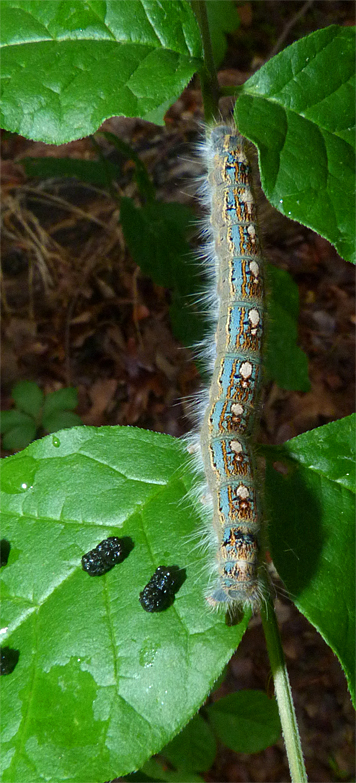
Within the past few weeks there have been many an Eastern Caterpillar rescued from “certain death” by some of the hundreds of children visiting the Museum on field trips from various schools throughout the state (out of state too). The caterpillars were coming down out of the trees to search for safe places to pupate, whether under a log, rock, or other protected and out of the way location. Hundreds of them were seen crossing the paths in both Catch the Wind and Explore the Wild. On one particularly busy day (for both caterpillars and children) it seemed as though every kid that walked by either had a caterpillar in their hand, or one crawling up their arm.
On April 23, I came across another species of tent caterpillar on a sapling hickory on the Dinosaur Trail.

Besides a different color pattern, Forest Tent Caterpillars overwinter as larvae, and do not weave silken tents in the crotches of trees as do the eastern variety of tent caterpillars. Eastern Tent Caterpillars overwinter as eggs on the host tree (usually Black Cherry), and build silken tents on the same tree.
One of these guys was hanging out on our cart the other day when we were parking buses! We were happy to have him as company.
I agree, they make excellent companions.
Mr. Dodge,
A friend of ours put a few tent caterpillars in a butterfly keeper to watch them transform into moths. However, what has emerged from the cocoon is a small yellow type worm. Have you ever seen anything like this or do you have some information that would solve this mystery. Thanks, Martha Harrington
Hi Martha,
Not having seen the “small yellow type worm” I can only guess that what has emerged from the tent caterpillar cocoon is the larva of a parasitoid fly or wasp, probably a tachinid fly. These flies deposit their eggs, or live maggots, either on the host itself (caterpillar) or on the cocoon of some unfortunate moth or butterfly caterpillar. The caterpillar, or pupa, is consumed by the fly larva (maggots).
Sounds a bit gruesome, but I guess it’s not much different than being eaten by a bird or stepped on by a human.
Hope that answer helps.
Thanks, and see you at the Museum!